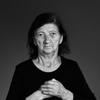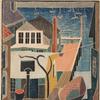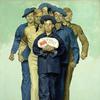Pulitzer Presents Major Exhibition Celebrating the Achievements of Acclaimed Artist Barbara Chase-Riboud
- ST. LOUIS, Missouri
- /
- June 23, 2022
This fall the Pulitzer Arts Foundation presents Barbara Chase-Riboud Monumentale: The Bronzes, a major monographic presentation examining the artistic vision of the Paris-based artist, novelist, and poet, Barbara Chase-Riboud (b. Philadelphia, 1939).
On view from September 16, 2022, to February 5, 2023, Barbara Chase-Riboud Monumentale: The Bronzes brings together some 40 major sculptures from the 1950s to the present day, accompanied by 20 drawings. The exhibition illustrates how the artist has developed a highly original visual language that is also fundamentally global and transhistorical, with influences ranging from Italian Baroque architecture to West African bronze making. Chase-Riboud has deftly wielded the centuries-old tradition of bronze monument-making.
Barbara Chase-Riboud Monumentale: The Bronzes has been organized by Pulitzer Arts Foundation Curator Stephanie Weissberg.
Pulitzer Executive Director Cara Starke states, “The Pulitzer is delighted to present the work of Barbara Chase-Riboud. She is one of the first female artists to produce work in bronze at the scale and complexity for which she is known, pushing the material to its very limits. This exhibition will illuminate the many ways in which she has advanced her singular formal and conceptual vision.”
Weissberg adds, “From her most recent sculptures to her earliest experiments in bronze, Chase-Riboud’s work has significantly broadened the definition of sculpture and asked important questions about who and what deserves to be remembered and monumentalized. She has put forth a remarkable body of sculpture, drawings, fictional writing, and poetry that together redefine the very meaning of monumentality.”
Exhibition Overview
Monumentale begins with an imposing work in the museum’s entrance courtyard: Standing Black Woman of Venice (2021). While the towering black bronze figure was created only last year, the mold from which it was cast is one that Chase-Riboud made more than fifty years ago. She completely reconceived its orientation for this new sculpture to achieve a monumentality and austerity that harken back to the standing figures of both ancient Egypt and Alberto Giacometti.
Moving on to the entrance gallery, the exhibition unfolds in loosely chronological order, beginning with Chase-Riboud’s earliest large-scale bronze, Adam and Eve (1958), which she created during a year-long fellowship at the American Academy in Rome. The seven-and-a-half-foot tall sculpture approaches abstraction in its depiction of the two Biblical figures huddled together under the sloping tree of knowledge. Like a number of other sculptures the artist created during her early years, the attenuated forms and rough-hewn surfaces here recall the iconic standing figures of Giacometti.
Six virtuosic drawings from a 1966 series, Le Lit, are also highlighted here. One depicts a man and woman in bed, their unnaturally elongated limbs taut and extended in opposite directions, the woman defined by a gently sloping belly. As the series progresses, the images become more abstract and eventually dissolve into geometric forms that resemble the rippling, pleated sheets of metal that the artist had already begun producing with sand-cast aluminum. Reminiscent of the undulating folds of the marble and bronze sculptures of the Italian Baroque artist Gian Lorenzo Bernini, the contours in these drawings signal the leap the artist was making in her corresponding sculptural practice. This shift is evident in Time Womb Jacqueline, a cast-aluminum sculpture from 1967, on view nearby.
The spacious main gallery features six monumental bronze abstractions drawn from the extensive Malcolm X series, where Chase-Riboud memorialized a historic figure—here the iconic civil-rights leader—for the first time. With the Malcolm X series, Chase-Riboud began to synthesize a number of the signatures of her mature style. One of these hallmarks can be seen in the textile ‘skirt’ attached as a base to the bronze ‘body’ of Malcolm X #13 (2008). The ‘skirt’ would become a fixed form in Chase-Riboud’s bronzes, allowing her to address her longstanding interest in achieving balance and tension by harnessing opposing forces. Stationed nearby, five other major bronzes from the series (Malcolm X #9, #16, #17, #18, and #19) speak to the artist’s evolving methods and her desire to pay tribute to the global Pan-African movement that began in the 1960s.
Throughout her career Chase-Riboud has returned again and again to certain visual ideas. This experimentation is evident here in her altering of scale and, most particularly, surface, as the brilliantly polished aluminum of earlier works has now morphed into gold and black bronze.
Also in this gallery is the ambitious La Musica Red Parkway/Josephine (2007) which pays tribute to Josephine Baker, the American icon who was born and raised in St. Louis but became a French citizen and was buried at the Pantheon in Paris. More than six feet in height, the red bronze figure with red silk ropes serves as a counterpoint to her Malcolm X series with an open form that terminates in coiled curls that resemble treble clefs or violin scrolls. With this work Chase-Riboud uses abstraction to visualize the physical embodiment of the acoustic while also celebrating the impact of Baker’s singular contributions to the twentieth-century musical landscape.
The museum’s cube gallery contains works from the Zanzibar series that Chase-Riboud began in the early 70s. As in the Malcolm X series, she addresses important historic injustices in the Zanzibar works, this time in reference to the East African archipelago that served as a center of the slave trade from as early as the 17th century. Here, Chase-Riboud advanced a number of the techniques she developed in the Malcolm X series, such as building three-dimensional forms with long thin strips of bronze. The exhibition features Zanzibar Table Gold and Zanzibar Table Black # 2, both 1972 bronzes in which the artist experimented with casting techniques, playing with height, volume, and monumentality, integrating silk, linen, and synthetic cords into bronze by looping and tying processes.
Moving to the first lower gallery, four major sculptural works refer obliquely to realities experienced by women. In Homage to Gustave Courbet (1967), Chase-Riboud makes reference to the 19th century painter’s infamous L’Origine du monde (The Origin of the World), of 1866, which depicted a naked torso and genitalia. Her work takes the form of a large black silk triangle framed by strips of brightly polished, crinkly bronze. The use of the triangle at this early date foreshadows her later interest in the form as symbolic of nature and creation in tantric philosophy. Also in this gallery is Nursery #3 (2007), a wall piece that rises as solid black bronze, silk, and rope before evaporating into limned blank space.
Chase-Riboud had earlier experimented with sand-casting aluminum, and two large-scale sculptures in this gallery show how she advanced the possibilities of the method. In Well of the Concubine Pearl (1967), she almost seems to be transforming metal into fiber and fiber into metal: that is, polished aluminum surfaces take on the lightness of fabric, while silk and woolen ropes project the illusion of permanence. Sand-casting aluminum allowed Chase-Riboud to keep molds, which in turn allowed her to revisit and reimagine earlier work (as in Standing Black Woman of Venice).
Monumentale next moves to Chase-Riboud’s Cleopatra series, which occupied her for almost thirty years and culminated in seven major sculptures. Four are on view here in one of the Pulitzer’s lower galleries. Each references a personal effect belonging to the queen of Ptolemaic Egypt: cape, door, chair, and wedding contract. Cleopatra’s Cape (1973), inspired by the jade burial suits of the Han Dynasty in China, is made of small plaques of bronze, hand-woven together. To achieve the iridescent quality she wanted, Chase-Riboud had to use a firing technique that produced many unpredictable results. She welcomed this element of chance and upped the ante by employing the Surrealist technique of automatism to create abstract designs that repeat across the cape’s surface.
The year after she completed Cleopatra’s Cape, Chase-Riboud published her first collection of poetry, From Memphis to Peking (1974). Six years later, she published her breakthrough historical fiction novel, Sally Hemings (1980), which caused a furor in the United States by asserting that there was a sexual relationship between Jefferson and the Sally Hemings, whom he enslaved. The publication marked an important turning point in Chase-Riboud’s career as the scope of her professional creative output grew beyond the realm of the visual. From that point on, she would toggle between writing and sculpture, working exclusively in one medium at a time.
Another lower gallery brings together a group of sculptures and drawings that were created by Chase-Riboud at different times as the basis for various public art commissions. In her public art, she often conceived of works that, in her own words, “crossed swords with public history,” making visible the overlooked and suppressed histories that stem from the institution of slavery.
The first large-scale memorial the artist conceived for the public realm was proposed to the Clinton Administration in the mid-1990s to “honor the 11 million victims and the 30 million deportees of the African diaspora.” On view here is the bronze scale model that Chase-Riboud cast in 1994 for Middle Passage Monument, which was never realized. The model depicts two heavy black posts connected by a central beam, bound with a length of chain.
Another highlight here is Africa Rising Bust Overcast #1 (1998). This small bronze was realized as a preliminary step in the creation of Africa Rising (1998), Chase Riboud’s massive bronze memorial to those interred in the African Burial Site in Lower Manhattan. The memorial stands today in the nearby Ted Weiss Federal Building and acknowledges “the transport of Africans to this land, their bondage and struggle for freedom.” It simultaneously conveys defiance, passion, and triumph in the compression and collision of juts, cuts, folds and pleats. Its subject is Sarah Baartman, a Khoekhoe woman who was brought to Paris under false pretenses in the early 1800s and displayed there as a curiosity. A pair of accompanying red pastel/black graphite drawings capture Baartman’s spirit as a passionate and complex human being.
Also in this gallery are four works on paper from the Monument Drawings Series, a portfolio of 24 drawings on etchings that Chase-Riboud created in just a few months between 1996 and ‘97. The selection depicts imaginary memorials to Émile Zola (for Paris); Shaka Zulu (for Harare); “Precious Concubine” Pearl (Imperial Noble Consort Keshun) (for Beijing); and Peter Paul Rubens’s mother Maria Pypelinckx (for Antwerp). The artist’s deft draftsmanship can be observed in the careful linework used to balance light and dark, delineate texture, and suggest form. Chase-Riboud’s architectural training is also evident as she describes built environments in multiple styles, with elevations sometimes embedded into larger drawings that integrate perspective, as in Zola’s Monument (1996).
Barbara Chase-Riboud Monumentale: The Bronzes culminates with works from Chase-Riboud’s largest body of work, La Musica, which she began in 1990 and has continued to the present day. This series makes oblique references to the forms of musical instruments and the bodies that play them. Two of the works in this gallery pay tribute to women of great historical significance and personal interest to the artist. Chase-Riboud’s gold bronze and silk sculpture La Musica Marian Anderson (2003) acknowledges the Philadelphia-native contralto Marian Anderson, who performed across the United States and Europe to great acclaim. Anne d’H (2008), a vertical gold bronze form bound with curling tendrils of wrapped gold silk, celebrates the late art historian and longtime director of the Philadelphia Art Museum, Anne d’Harnoncourt. Together with La Musica Red Parkway/Josephine (2007), installed in the main gallery, these works can be seen as a precis on the language of monumental sculpture developed by Chase-Riboud and employed to honor women who shaped the artistic and musical identities of Philadelphia, her hometown; Paris, her chosen home; and St. Louis, the location of the Pulitzer.
Barbara Chase-Riboud
Barbara Chase-Riboud (b. 1939, Philadelphia) is a renowned artist, an award-winning poet and a bestselling novelist. Her career can be said to have begun when she crossed the Atlantic to spend a year as a fellow at the American Academy in Rome in 1957. She later graduated from Yale’s School of Architecture (1960) and moved to Europe. There she pursued an independent track, gaining training in a variety of sculpture-making skills and showing in museums and galleries. Her remarkable life has included decades of travel and life at the center of artistic, literary, and political circles that also included luminaries ranging from Henri Cartier-Bresson, Salvador Dalí, Alexander Calder, James Baldwin, and Mao Zedong to Toni Morrison, Pierre Cardin, Jacqueline Kennedy Onassis, and Josephine Baker.
Chase-Riboud is the recipient of numerous awards, including a Knighthood of the French Légion d’Honneur, the Grand Prix Artistique from the Simone and Cino Del Duca Foundation, the AWARE Prix d’Honneur, the Tannie Award in the Visual Arts in Paris, and the Women’s Caucus for Art Lifetime Achievement Award from the College Art Association. She is represented in the permanent collections of the Museum of Modern Art, Metropolitan Museum of Art, and Whitney Museum of American Art, among other museums.
Publications
The exhibition will be accompanied by two publications, both co-published by the Pulitzer Arts Foundation and Princeton University Press. Barbara Chase-Riboud Monumentale: The Bronzes is a fully illustrated catalogue, offering further exploration of the artist’s oeuvre, with essays by Courtney J. Martin, Director of the Yale Center for British Art, New Haven, CT; Christophe Cherix, The Robert Lehman Foundation Chief Curator of Drawings and Prints at The Museum of Modern Art, New York; Akili Tommasino, Associate Curator, Modern and Contemporary Art at The Metropolitan Museum of Art, New York; Erin Gilbert, New York-based curator and art advisor specializing in Modern and Contemporary Art of the African Diaspora; and Stephanie Weissberg. I Always Knew: A Memoir is a collection of letters written by Chase-Riboud to her mother, Vivian Mae Chase, sharing narratives of lives entwined over nearly four decades.
About the Pulitzer Arts Foundation
The Pulitzer Arts Foundation is an art museum dedicated to fostering meaningful experiences with art and architecture. Since its founding in 2001, the museum has presented art from around the world in its celebrated building by Tadao Ando and its surrounding neighborhood. Offering personal encounters with art, the Pulitzer brings art and people together to explore ideas and inspire new perspectives.
The Pulitzer campus is located in the Grand Center Arts District of St. Louis, Missouri, and includes the museum, the Park-Like garden, a tree grove, and the forthcoming Spring Church (opening July 2022). The museum is open Thursday through Sunday, 10am–5pm, with evening hours until 8pm on Friday. Admission is free. For more information, visit pulitzerarts.org.
















